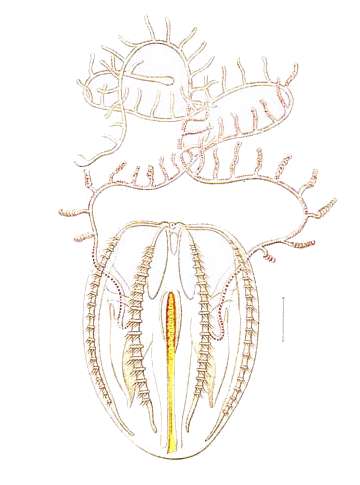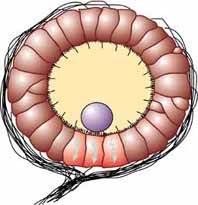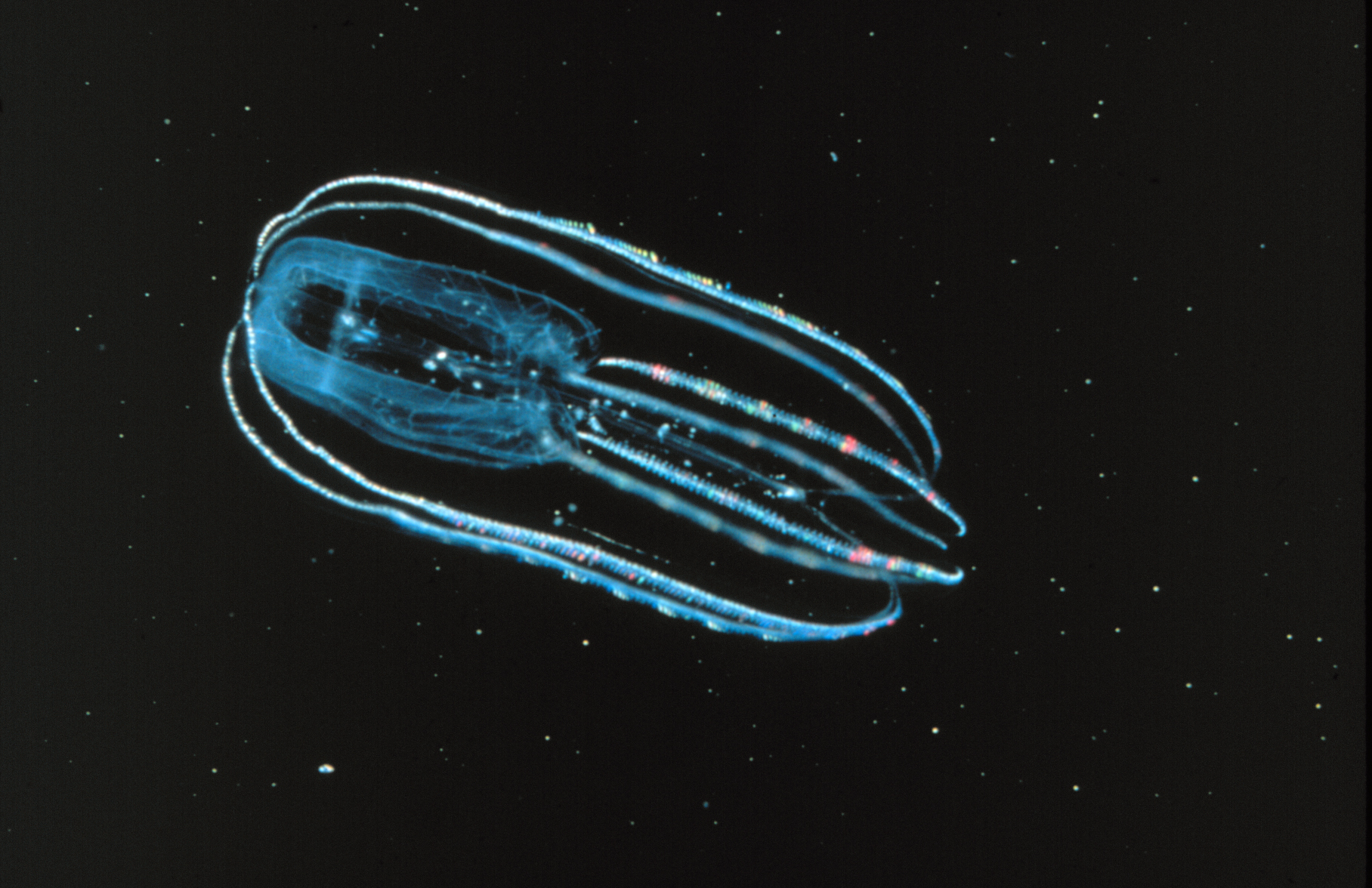|
Euplokamidae
''Euplokamis'' is a genus of ctenophores, or comb jellies, belonging to the monotypic family Euplokamididae. Despite living for hundreds of millions of years in marine environments, there is minimal research regarding ''Euplokamis'', primarily due to their body structure. Research on the evolution of the basic body structures of diploblastic metazoans revealed that there are four major phyla, including the Ctenophores. Although the morphology of ''Euplokamis'' often resembles the medusa stage of Cnidarians, their eight rows of combs are one distinguishing feature that led to the official classification of Ctenophores. After being originally described by Chun (1879), the family ''Euplokamididae'' was expanded by Mills (1987) due to the discovery of a new species, ''Euplokamis dunlapae''. Further research indicated that ''Euplokamis'' should be identified from Mertensiidae due to the rows of combs and some compression. They may also be distinguished from the genus '' Pleurobrachia'' ... [...More Info...] [...Related Items...] OR: [Wikipedia] [Google] [Baidu] |
Euplokamidae
''Euplokamis'' is a genus of ctenophores, or comb jellies, belonging to the monotypic family Euplokamididae. Despite living for hundreds of millions of years in marine environments, there is minimal research regarding ''Euplokamis'', primarily due to their body structure. Research on the evolution of the basic body structures of diploblastic metazoans revealed that there are four major phyla, including the Ctenophores. Although the morphology of ''Euplokamis'' often resembles the medusa stage of Cnidarians, their eight rows of combs are one distinguishing feature that led to the official classification of Ctenophores. After being originally described by Chun (1879), the family ''Euplokamididae'' was expanded by Mills (1987) due to the discovery of a new species, ''Euplokamis dunlapae''. Further research indicated that ''Euplokamis'' should be identified from Mertensiidae due to the rows of combs and some compression. They may also be distinguished from the genus '' Pleurobrachia'' ... [...More Info...] [...Related Items...] OR: [Wikipedia] [Google] [Baidu] |
Carl Chun
Carl Chun (1 October 1852 – 11 April 1914) was a German marine biologist. Chun was born in Höchst, today a part of Frankfurt, and studied zoology at the University of Leipzig, where from 1878 to 1883 he was privat-docent of zoology and an assistant to Rudolf Leuckart. After professorial posts in Königsberg (1883–1891) and Breslau (1891–1898), he returned to Leipzig as a professor of zoology.UNI Leipzig Professorenkatalog (biographical sketch) In 1888, Chun described seasonal vertical migration (SVM) which has a periodicity of ca. 1 year. Chun examined depth-stratified net samples from the |
Pelagic Ctenophores
The pelagic zone consists of the water column of the open ocean, and can be further divided into regions by depth (as illustrated on the right). The word ''pelagic'' is derived . The pelagic zone can be thought of as an imaginary cylinder or water column between the surface of the sea and the bottom. Conditions in the water column change with depth: pressure increases; temperature and light decrease; salinity, oxygen, micronutrients (such as iron, magnesium and calcium) all change. Marine life is affected by bathymetry (underwater topography) such as the seafloor, shoreline, or a submarine seamount, as well as by proximity to the boundary between the ocean and the atmosphere at the ocean surface, which brings light for photosynthesis, predation from above, and wind stirring up waves and setting currents in motion. The pelagic zone refers to the open, free waters away from the shore, where marine life can swim freely in any direction unhindered by topographical constraints. The ... [...More Info...] [...Related Items...] OR: [Wikipedia] [Google] [Baidu] |
Gastrovascular Cavity
The gastrovascular cavity is the primary organ of digestion and circulation in two major animal phyla: the Coelenterates or cnidarians (including jellyfish and corals) and Platyhelminthes (flatworms). The cavity may be extensively branched into a system of canals. In cnidarians, the gastrovascular system is also known as the coelenteron, and is commonly known as a "blind gut" or "blind sac", since food enters and waste exits through the same orifice. The radially symmetrical cnidarians have a sac-like body in two distinct layers, the epidermis and gastrodermis, with a jellylike layer called the mesoglea between. Extracellular digestion takes place within the central cavity of the sac-like body. This cavity has only one opening to the outside which, in most cnidarians, is surrounded by tentacle In zoology, a tentacle is a flexible, mobile, and elongated organ present in some species of animals, most of them invertebrates. In animal anatomy, tentacles usually occur in one ... [...More Info...] [...Related Items...] OR: [Wikipedia] [Google] [Baidu] |
Pharynx
The pharynx (plural: pharynges) is the part of the throat behind the mouth and nasal cavity, and above the oesophagus and trachea (the tubes going down to the stomach and the lungs). It is found in vertebrates and invertebrates, though its structure varies across species. The pharynx carries food and air to the esophagus and larynx respectively. The flap of cartilage called the epiglottis stops food from entering the larynx. In humans, the pharynx is part of the digestive system and the conducting zone of the respiratory system. (The conducting zone—which also includes the nostrils of the nose, the larynx, trachea, bronchi, and bronchioles—filters, warms and moistens air and conducts it into the lungs). The human pharynx is conventionally divided into three sections: the nasopharynx, oropharynx, and laryngopharynx. It is also important in vocalization. In humans, two sets of pharyngeal muscles form the pharynx and determine the shape of its lumen. They are arranged as an ... [...More Info...] [...Related Items...] OR: [Wikipedia] [Google] [Baidu] |
Nematocytes
A cnidocyte (also known as a cnidoblast or nematocyte) is an explosive cell containing one large secretory organelle called a cnidocyst (also known as a cnida () or nematocyst) that can deliver a sting to other organisms. The presence of this cell defines the phylum Cnidaria (corals, sea anemones, hydrae, jellyfish, etc.). Cnidae are used to capture prey and as a defense against predators. A cnidocyte fires a structure that contains a toxin within the cnidocyst; this is responsible for the stings delivered by a cnidarian. Structure and function Each cnidocyte contains an organelle called a cnida, cnidocyst, nematocyst, ptychocyst or spirocyst. This organelle consists of a bulb-shaped capsule containing a coiled hollow tubule structure attached to it. An immature cnidocyte is referred to as a cnidoblast or nematoblast. The externally oriented side of the cell has a hair-like trigger called a cnidocil, which is a mechano- and chemo-receptor. When the trigger is activated, t ... [...More Info...] [...Related Items...] OR: [Wikipedia] [Google] [Baidu] |
Statocyst
The statocyst is a balance sensory receptor present in some aquatic invertebrates, including bivalves, cnidarians, ctenophorans, echinoderms, cephalopods, and crustaceans. A similar structure is also found in ''Xenoturbella''. The statocyst consists of a sac-like structure containing a mineralised mass (statolith) and numerous innervated sensory hairs (setae). The statolith's inertia causes it to push against the setae when the animal accelerates. Deflection of setae by the statolith in response to gravity activates neurons, providing feedback to the animal on change in orientation and allowing balance to be maintained. In other words, the statolith shifts as the animal moves. Any movement large enough to throw the organism off balance causes the statolith to brush against tiny bristles which in turn send a message to the brain to correct its balance. It may have been present in the common ancestor of cnidarians and bilaterians. Hearing In cephalopods like squids, statocysts ... [...More Info...] [...Related Items...] OR: [Wikipedia] [Google] [Baidu] |
Genus
Genus ( plural genera ) is a taxonomic rank used in the biological classification of extant taxon, living and fossil organisms as well as Virus classification#ICTV classification, viruses. In the hierarchy of biological classification, genus comes above species and below family (taxonomy), family. In binomial nomenclature, the genus name forms the first part of the binomial species name for each species within the genus. :E.g. ''Panthera leo'' (lion) and ''Panthera onca'' (jaguar) are two species within the genus ''Panthera''. ''Panthera'' is a genus within the family Felidae. The composition of a genus is determined by taxonomy (biology), taxonomists. The standards for genus classification are not strictly codified, so different authorities often produce different classifications for genera. There are some general practices used, however, including the idea that a newly defined genus should fulfill these three criteria to be descriptively useful: # monophyly – all descendants ... [...More Info...] [...Related Items...] OR: [Wikipedia] [Google] [Baidu] |
Tentilla
In zoology, a tentacle is a flexible, mobile, and elongated organ present in some species of animals, most of them invertebrates. In animal anatomy, tentacles usually occur in one or more pairs. Anatomically, the tentacles of animals work mainly like muscular hydrostats. Most forms of tentacles are used for grasping and feeding. Many are sensory organs, variously receptive to touch, vision, or to the smell or taste of particular foods or threats. Examples of such tentacles are the eyestalks of various kinds of snails. Some kinds of tentacles have both sensory and manipulatory functions. A tentacle is similar to a cirrus, but a cirrus is an organ that usually lacks the tentacle's strength, size, flexibility, or sensitivity. A nautilus has cirri, but a squid has tentacles. Invertebrates Molluscs Many molluscs have tentacles of one form or another. The most familiar are those of the pulmonate land snails, which usually have two sets of tentacles on the head: when extended t ... [...More Info...] [...Related Items...] OR: [Wikipedia] [Google] [Baidu] |
Cestida
Cestidae is a family of comb jellies. It is the only family in the monotypic order Cestida. Unlike other comb jellies, the body of cestids is greatly flattened, and drawn out into a long ribbon-like shape. The two tentacles are greatly shortened, and two of the four ciliated comb rows are reduced. The unusual body form allows the animals to swim by means of muscular undulation, as well as by using their cilia. The largest species, belonging to the genus ''Cestum'', can reach in length. Classification The order Cestida has one family, Cestidae, which contains two genera: '' Cestum'' and ''Velamen''. Each genus contains one species In biology, a species is the basic unit of classification and a taxonomic rank of an organism, as well as a unit of biodiversity. A species is often defined as the largest group of organisms in which any two individuals of the appropriate s .... * '' Cestum veneris'' Lesueur, 1813 * '' Velamen parallelum'' (Fol, 1869) References T ... [...More Info...] [...Related Items...] OR: [Wikipedia] [Google] [Baidu] |
Lobata
Lobata is an order of Ctenophora in the class Tentaculata with smaller tentacles than other ctenophores, and distinctive flattened lobes extending outwards from their bodies. They grow up to about long. Anatomy The lobates have a pair of lobes, which are muscular, cuplike extensions of the body that project beyond the mouth. Their inconspicuous tentacles originate from the corners of the mouth, running in convoluted grooves and spreading out over the inner surface of the lobes (rather than trailing far behind, as in the Cydippida). Between the lobes on either side of the mouth, many species of lobates have four auricles, gelatinous projections edged with cilia that produce water currents that help direct microscopic prey toward the mouth. This combination of structures enables lobates to feed continuously on suspended planktonic prey. Lobates have eight comb-rows, originating at the aboral pole and usually not extending beyond the body to the lobes; in species with (four) au ... [...More Info...] [...Related Items...] OR: [Wikipedia] [Google] [Baidu] |
Cydippida
Cydippida is an order of comb jellies. They are distinguished from other comb jellies by their spherical or oval bodies, and the fact their tentacles are branched, and can be retracted into pouches on either side of the pharynx. The order is not monophyletic, that is, more than one common ancestor is believed to exist. Anatomy Cydippids have bodies that are more or less rounded, sometimes nearly spherical and other times more cylindrical or egg-shaped; the common coastal "sea gooseberry," '' Pleurobrachia'', has an egg-shaped body with the mouth at the narrow end. From opposite sides of the body extends a pair of long, slender tentacles, each housed in a sheath into which it can be withdrawn. Some species of cydippids have bodies that are flattened to various extents, so that they are wider in the plane of the tentacles. The tentacles are typically fringed with tentilla ("little tentacles"), although a few genera have simple tentacles without these side-branches. The tentacles an ... [...More Info...] [...Related Items...] OR: [Wikipedia] [Google] [Baidu] |







